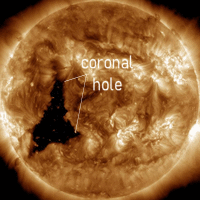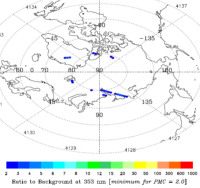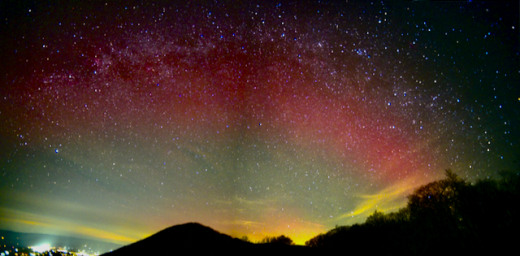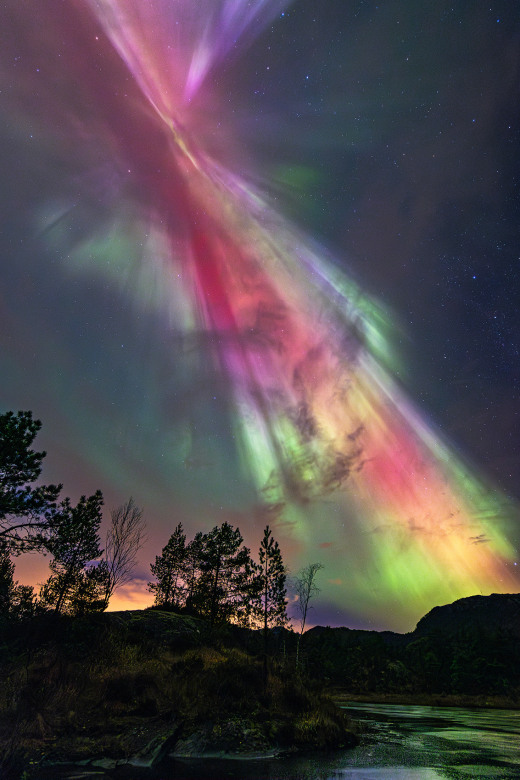 | | | Switch to: Europe, USA, New Zealand, Antarctica Credit: NOAA/Ovation  Planetary K-index Planetary K-index
Now: Kp= 1.33 quiet
24-hr max: Kp= 2.00 quiet
explanation | more data
Interplanetary Mag. Field
Btotal: 9.67 nT
Bz: 3.02 nT north
more data: ACE, DSCOVR
Updated: Today at 1145 UT  Coronal Holes: 30 Nov 23 Coronal Holes: 30 Nov 23 
Solar wind flowing from this large coronal hole should reach Earth on Dec. 4. Credit: SDO/AIA  Noctilucent Clouds Noctilucent Clouds
The northern season for NLCs began on May 26th. The first clouds were detected inside the Arctic Circle by the NOAA 21 satellite. An instrument onboard NOAA 21 (OMPS LP) is able to detect NLCs (also known as "polar mesospheric clouds" or PMCs). For the rest of the season, daily maps from NOAA 21 will be presented here:

Updated: Aug. 29, 2023
Each dot is a detected cloud. As the season progresses, these dots will multiply in number and shift in hue from blue to red as the brightness of the clouds intensifies.
What happened to NASA's AIM spacecraft, which has been monitoring NLCs since 2007? Earlier this year, the spacecraft's battery failed. As a result AIM is offline, perhaps permanently. There may be some hope of a recovery as AIM's orbit precesses into full sunlight in 2024. Until then, we will maintain AIM's iconic "daily daisy," frozen at Feb. 28, 2023, as a show of thanks for years of service and hope for future daisies:  |  |  | Switch view:Ross Ice Shelf, Antarctic Peninsula, East Antarctica, Polar Updated Nov30  SPACE WEATHER
NOAA Forecasts | | Updated at: 2023 Nov 30 2200 UTC FLARE | 0-24 hr | 24-48 hr | CLASS M | 35 % | 35 % | CLASS X | 10 % | 10 % |  Geomagnetic Storms: Geomagnetic Storms:
Probabilities for significant disturbances in Earth's magnetic field are given for three activity levels: active, minor storm, severe storm Updated at: 2023 Nov 30 2200 UTC Mid-latitudes | 0-24 hr | 24-48 hr | ACTIVE | 20 % | 35 % | MINOR | 30 % | 25 % | SEVERE | 40 % | 05 % | High latitudes | 0-24 hr | 24-48 hr | ACTIVE | 10 % | 15 % | MINOR | 20 % | 20 % | SEVERE | 60 % | 20 % | | | |  | | | | | | | | | | | This is an AI Free Zone! Text created by ChatGPT and other Large Language Models is spreading rapidly across the Internet. It's well-written, artificial, frequently inaccurate. If you find a mistake on Spaceweather.com, rest assured it was made by a real human being. | | | A CANNIBAL CME IS COMING: NOAA models confirm that a Cannibal CME will strike our planet on Dec. 1st. Cannibal CMEs form when a fast CME sweeps up a slower CME ahead of it. The combination contains intense, tangled magnetic fields that can do a good job sparking auroras when they reach Earth. If a Cannibal CME strikes Earth on Dec. 1st, as predicted, geomagnetic storm levels could reach category G3 (Strong). Aurora alerts: SMS Text WHAT HAPPENS DURING A STRONG GEOMAGNETIC STORM? Earth could experience a strong (G3) geomagnetic storm this week. If so, here's what we can expect. The last G3-class storm on Nov. 5th sparked not only bright auroras, but also deep-red SAR arcs around the world. Greg Redfern photographed this example from the Shenandoah National Park in Virginia: 
"I didn't realize I had photographed an SAR arc until I processed my images the next day, stitching two of them together to reveal its shape," says Redfern. SAR arcs look like auroras, but they are not. They are the glow of heat energy leaking into the upper atmosphere from Earth's ring current system–a donut-shaped circuit carrying millions of amps around our planet. During the Nov. 5th geomagnetic storm, these red arcs were observed as far south as Texas and California. Auroras were observed as well -- "and they were INSANE," says Janne Maj Nagelsen, who watched the display from Stamnes, Vaksdal, Norway: 
"I have never seen such strong auroras," says Nagelsen. "Not to mention the colors. I mean look at the picture! They were totally, literally insane." Auroras are caused by charged particles raining from space down upon Earth's atmosphere. Unlike SAR arcs, which are pure red, auroras can have a rich and stunning variety of colors. Both phenomena may be photographed on Dec. 1, 2023, when a Cannibal CME is expected to hit Earth. Would you like to know when the CME arrives? Sign up for our Space Weather Alert Service and you'll receive an instant text message when the Cannibal CME strikes. Realtime Aurora Photo Gallery
Free: Spaceweather.com Newsletter CHRISTMAS GIFTS FROM THE EDGE OF SPACE: Christmas is coming. Are you looking for a far-out gift? Check out the Earth to Sky Store. It's filled with unique items that have flown to the edge of space onboard cosmic ray research balloons.

Carried aloft by giant helium balloons, these unique gifts have flown above 99.7% of Earth's atmosphere, experiencing space-like blasts of cosmic rays, extreme cold, and a wild ride parachuting back to Earth after the balloon explodes. Even Amazon doesn't carry items this far out. Don't forget to enter coupon code "SPACEPICKLE" at checkout for a 15% Black Friday discount.
Far Out Gifts: Earth to Sky Store
All sales support hands-on STEM educatio
Realtime Comet Photo Gallery
Free: Spaceweather.com Newsletter
Realtime Space Weather Photo Gallery
Free: Spaceweather.com Newsletter
Every night, a network of NASA all-sky cameras scans the skies above the United States for meteoritic fireballs. Automated software maintained by NASA's Meteoroid Environment Office calculates their orbits, velocity, penetration depth in Earth's atmosphere and many other characteristics. Daily results are presented here on Spaceweather.com. On Nov 28, 2023, the network reported 9 fireballs.
(8 sporadics, 1 Leonid)  In this diagram of the inner solar system, all of the fireball orbits intersect at a single point--Earth. The orbits are color-coded by velocity, from slow (red) to fast (blue). [Larger image] [movies] Potentially Hazardous Asteroids ( PHAs) are space rocks larger than approximately 100m that can come closer to Earth than 0.05 AU. None of the known PHAs is on a collision course with our planet, although astronomers are finding new ones all the time. On November 30, 2023 there were 2349 potentially hazardous asteroids.
 | Recent & Upcoming Earth-asteroid encounters: | Asteroid | Date(UT) | Miss Distance | Velocity (km/s) | Diameter (m) | | 2019 CZ2 | 2023-Nov-25 | 2.8 LD | 5.8 | 44 | | 2023 VH5 | 2023-Nov-25 | 17.9 LD | 9 | 33 | | 2023 WN2 | 2023-Nov-26 | 7.4 LD | 14.9 | 75 | | 2023 WT2 | 2023-Nov-26 | 2.2 LD | 13.6 | 10 | | 2023 VM1 | 2023-Nov-26 | 10.9 LD | 8.9 | 42 | | 2013 UB3 | 2023-Nov-27 | 18.5 LD | 5.4 | 25 | | 2023 WE1 | 2023-Nov-28 | 7.8 LD | 13 | 16 | | 2023 VR5 | 2023-Nov-28 | 5.3 LD | 3 | 11 | | 2023 VY8 | 2023-Nov-29 | 17 LD | 20 | 35 | | 2023 WC1 | 2023-Nov-30 | 5.7 LD | 7.8 | 19 | | 2023 WD3 | 2023-Dec-01 | 8 LD | 14 | 35 | | 2023 VM7 | 2023-Dec-01 | 6.4 LD | 3.2 | 11 | | 1998 WB2 | 2023-Dec-03 | 11 LD | 14.2 | 151 | | 2013 VX4 | 2023-Dec-04 | 5.1 LD | 6.6 | 60 | | 2023 WW | 2023-Dec-05 | 7.8 LD | 8.5 | 41 | | 2023 TB27 | 2023-Dec-06 | 17 LD | 4.3 | 44 | | 139622 | 2023-Dec-06 | 14.4 LD | 6.7 | 719 | | 2023 VF12 | 2023-Dec-08 | 13 LD | 4.1 | 22 | | 2023 WG | 2023-Dec-08 | 17.6 LD | 6.6 | 37 | | 2023 WH | 2023-Dec-10 | 11.9 LD | 8.9 | 39 | | 2020 HX3 | 2023-Dec-10 | 9.8 LD | 15.7 | 13 | | 2010 XF3 | 2023-Dec-11 | 19.4 LD | 4 | 46 | | 2016 XD2 | 2023-Dec-19 | 18.7 LD | 6.9 | 59 | | 341843 | 2023-Dec-20 | 16.5 LD | 5.3 | 344 | | 2018 YJ2 | 2023-Dec-21 | 18.4 LD | 13.1 | 154 | | 2022 YG | 2023-Dec-22 | 10.8 LD | 5.1 | 17 | | 2023 VD6 | 2023-Dec-23 | 10.6 LD | 15.5 | 156 | | 2020 YO3 | 2023-Dec-23 | 3.6 LD | 16.6 | 42 | | 2010 UE51 | 2023-Dec-24 | 9 LD | 1.3 | 7 | | 2020 YR2 | 2023-Dec-25 | 13.8 LD | 8 | 8 | | 2021 AM6 | 2023-Dec-31 | 18.3 LD | 6.6 | 17 | | 2019 KK5 | 2024-Jan-03 | 10.6 LD | 20.9 | 98 | | 2002 AY1 | 2024-Jan-08 | 15.2 LD | 17.3 | 230 | | 2020 AC1 | 2024-Jan-11 | 19.3 LD | 5.3 | 7 | | 2021 CZ2 | 2024-Jan-16 | 8 LD | 14.3 | 113 | | 2021 BL3 | 2024-Jan-23 | 17.2 LD | 23.4 | 41 | | 2017 BG92 | 2024-Jan-25 | 11.8 LD | 6.3 | 6 | | 2011 CQ1 | 2024-Jan-26 | 11.3 LD | 4.6 | 1 | Notes: LD means "Lunar Distance." 1 LD = 384,401 km, the distance between Earth and the Moon. 1 LD also equals 0.00256 AU. | | Cosmic Rays in the Atmosphere | SPACE WEATHER BALLOON DATA: Almost once a week, Spaceweather.com and the students of Earth to Sky Calculus fly space weather balloons to the stratosphere over California. These balloons are equipped with sensors that detect secondary cosmic rays, a form of radiation from space that can penetrate all the way down to Earth's surface. Our monitoring program has been underway without interruption for 7 years, resulting in a unique dataset of in situ atmospheric measurements. Latest results (July 2022): Atmospheric radiation is decreasing in 2022. Our latest measurements in July 2022 registered a 6-year low: 
What's going on? Ironically, the radiation drop is caused by increasing solar activity. Solar Cycle 25 has roared to life faster than forecasters expected. The sun's strengthening and increasingly tangled magnetic field repels cosmic rays from deep space. In addition, solar coronal mass ejections (CMEs) sweep aside cosmic rays, causing sharp reductions called "Forbush Decreases." The two effects blend together to bring daily radiation levels down. .Who cares? Cosmic rays are a surprisingly "down to Earth" form of space weather. They can alter the chemistry of the atmosphere, trigger lightning, and penetrate commercial airplanes. According to a study from the Harvard T.H. Chan school of public health, crews of aircraft have higher rates of cancer than the general population. The researchers listed cosmic rays, irregular sleep habits, and chemical contaminants as leading risk factors. A number of controversial studies (#1, #2, #3, #4) go even further, linking cosmic rays with cardiac arrhythmias and sudden cardiac death. Technical notes: The radiation sensors onboard our helium balloons detect X-rays and gamma-rays in the energy range 10 keV to 20 MeV. These energies span the range of medical X-ray machines and airport security scanners. Data points in the graph labeled "Stratospheric Radiation" correspond to the peak of the Regener-Pfotzer maximum, which lies about 67,000 feet above central California. When cosmic rays crash into Earth's atmosphere, they produce a spray of secondary particles that is most intense at the entrance to the stratosphere. Physicists Eric Regener and Georg Pfotzer discovered the maximum using balloons in the 1930s and it is what we are measuring today. | | The official U.S. government space weather bureau | | | The first place to look for information about sundogs, pillars, rainbows and related phenomena. | | | Researchers call it a "Hubble for the sun." SDO is the most advanced solar observatory ever. | | | 3D views of the sun from NASA's Solar and Terrestrial Relations Observatory | | | Realtime and archival images of the Sun from SOHO. | | | information about sunspots based on the latest NOAA/USAF Active Region Summary | | | current counts of failed and deployed Starlink satellites from Jonathan's Space Page | | | Authoritative predictions of space junk and satellite re-entries | | | from the NOAA Space Environment Center | | | fun to read, but should be taken with a grain of salt! Forecasts looking ahead more than a few days are often wrong. | | | from the NOAA Space Environment Center | | | the underlying science of space weather |  | When looking for casinos to play online when the weather is bad, you can try casino online trucchi for Italian games. If you are not from Finland you can try the Swedish page Svenska casino online to find suitable games, check out svenskacasinoonline.net. Always check your local laws before playing with real money. |  | BestCSGOGambling is the best site for everything related to CSGO gambling on the web | | | These links help Spaceweather.com stay online. Thank you to our supporters! | | | | | | | | |  | |  |   | ©2021 Spaceweather.com. All rights reserved. This site is penned daily by Dr. Tony Phillips. | |

